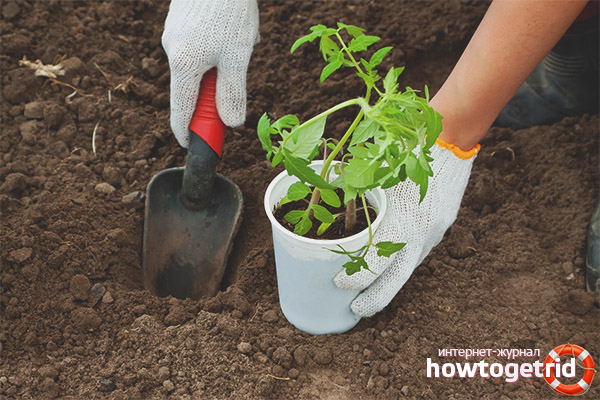The content of the article
Valya's tall crop tomato is a demanding plant. Under adverse weather conditions, frequent and prolonged rains, the crop is susceptible to disease. Growing these tomatoes will require certain knowledge, skills and patience from the gardener.
Description
Valya hybrid F1 is an indeterminate plant with large oval fruits. The hybrid is recommended for cultivation under film shelters and in the open ground. Bushes are powerful, sparse, 1.5 m high, require garters to support. The fruits are large, collected in massive brushes. The plants grow intensively in width, it is not recommended to plant bushes close to each other.
Growing seedlings
Planting the seeds of Val's tomato is best one at a time. Ordinary plastic cups or peat tablets are perfect for this. Pour soil into a glass, watered and gently deepen the seed, about one centimeter. Glasses with planted seeds should be covered with foil and put in a warm, dark place.
- Glasses in which seedlings will develop are filled with a sand-peat mixture. Until the first sprouts appear on the soil surface, the glasses are kept in a room with a temperature of at least twenty degrees.
- In most cases, after eight days, the first shoots appear. An ideal place to stay seedlings is the window sill of the south window. If you could not provide the seedlings with this condition, then organize them an additional source of lighting.
- Tomato seedlings feel comfortable in porous and permeable soil. One of the conditions is timely watering. And the best option would be if the soil intended for growing this crop is sandy loam.
- The most suitable fertilizer for young seedlings is compost from plant debris. It can be prepared by any gardener on his own site. Compost is most often prepared from fresh grass, leaves or food debris. Compost is well suited for enriching the soil with nutrients on the site, as well as for preparing the soil for seedlings.
- Seedlings are usually grown in the second half of March. You can plant seedlings in the ground after four weeks from the moment of its planting. Do not rush to planting seedlings, as this can lead to disastrous consequences. It will be best if you wait for the onset of constant heat.
- If it is decided to plant seeds in the soil, not seedlings, then this can only be done if the soil was covered with a film during the spring. If the soil is covered with a film, then when planting seeds it is not necessary to remove it, you can just make cross-shaped notches for sowing.
- The process of tomato development is divided into two periods. During the first, an ovary forms and primary growth occurs. Everything that happens after this refers to the second stage, which ends with the full ripening of the tomato.
- In the first three months, processes of oxidation and synthesis of substances actively occur in young plants, so seedlings need to be fed. The second stage of development is characterized by a slowdown in the synthesis of substances, at which time anaerobic processes prevail.
When growing potted seedlings, much attention is paid to soil preparation. The soil is disinfected to prevent disease. Seeds are sown in a pre-sanitized container. Shallow boxes, plastic cups, peat pots are used as containers.
Landing
Two weeks before the planned planting in the ground, it is necessary to begin hardening of seedlings in the fresh air.Avoid drafts. It is allowed to transplant into the ground as soon as the average daily temperature reaches 15-17 degrees. And on the plants the first buds are formed. Tomato does not like cold and heavy soil. In the presence of clay soil, peat and humus should be added.
When planting, it is recommended to add peat to the wells. This fertilizer is most often used in dung-peat mixtures. Peat perfectly improves the structure of the soil. When making peat, the soil becomes more crumbly.
Every gardener knows that without fertilizing, to grow a good crop of tomatoes, and especially large-fruited ones, is quite problematic. For the growth and development of plants, a large number of different nutrients are required. Of course, even without fertilizing, the plants will develop and even bear fruit, but in this case a good harvest should not be expected.
Before transplanting seedlings into the ground, the soil in pots is moistened, so as to easily extract the plant without harming the root system.
A small amount of nitrophoska is added to the wells into which the culture needs to be transplanted, and then watered. The distance between plants should be at least 40 centimeters.
They try to dig seedlings deeper into the soil so that additional roots form on the trunk. After planting, seedlings for a couple of days must be protected from direct sunlight.
Top dressing
When growing tomatoes, two types of fertilizers are used - mineral and organic. The best organic for Val's tomato is manure.
Attention! Rotted manure is brought into the soil. Although you can use fresh (it is added to the soil in the autumn for digging).
Well established bird droppings when growing tall tomatoes. It is a fast and powerful organic fertilizer. In the soil for digging, bird droppings are rarely applied. Most often used as top dressing tomato seedlings in the early stages of development. Bred in 10 liters of water 0.3 liters of bird droppings and water the plants under the root. It is a good source of nitrogen.
Wood ash is a universal fertilizer that is applied to any vegetable and berry crops. But most of all, crops such as potatoes, eggplant and tomatoes are needed. If the plot is acidic soils, it is advisable to make ash. It deoxidizes the soil.
Video: Valya tomato variety











Submit